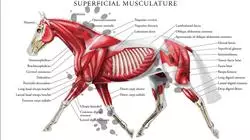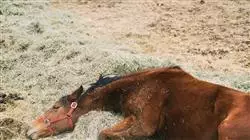University certificate
The world's largest faculty of veterinary medicine”
Introduction to the Program
A complete and total update on Field Musculoskeletal and Dermatological Surgical Disorders in Horses and Foals with the most complete and effective online educational program on the market"

The examination, diagnosis and treatment of disorders of the locomotor system are one of the main occupations in the clinical equine medicine field, so it is of primary importance for the veterinarian to have the knowledge and skills necessary to develop this specialty from their professional work.
Equestrian competitions are developed from regional and national levels, starting from basic riding, to higher national competitions and reaching international and world competitions of the highest level, with some equestrian sports reaching Olympic and Paralympic levels.
These disorders have a high economic impact on the equine sector and represent a large part of the work of the equine veterinarian, who has to deal with them almost daily.
In addition, because of their economic relevance, these disorders are the subject of constant research, so the advances in new diagnostic and treatment methods are dynamic and are always relevant.
It is for this reason that professionals must update their knowledge and correctly use the portable diagnostic equipment, which are the same in both cases. This is why this diagnostic tool is of special interest in the thoracic and abdominal regions, which can be examined practically 100% in these young patients, making radiology and ultrasound an essential tool, and the veterinarian must implement and optimize their performance in the outpatient clinical pediatric medicine.
The exclusive Masterclasses given by an international renowned expert are one of the main characteristics of this Postgraduate diploma in Field Musculoskeletal and Dermatological Surgical Disorders in Horses and Foals. Students will be able to benefit from the experience and knowledge of this leading expert in the equine field, and gain an in-depth understanding of the approach to various disorders of the horse and foal with an international and distinguished vision.
The inclusion of Masterclasses given by an international expert will allow you to learn new perspectives and approaches in the field of equine surgical disorders"
This Postgraduate diploma in Field Musculoskeletal and Dermatological Surgical Disorders in Horses and Foals contains the most complete and up-to-date scientific program on the market. The most important features include:
- The latest technology in online teaching software
- A highly visual teaching system, supported by graphic and schematic contents that are easy to assimilate and understand
- Practical cases presented by practicing experts
- State-of-the-art interactive video systems
- Teaching supported by telepractice
- Continuous updating and recycling systems
- Autonomous learning: full compatibility with other occupations
- Practical exercises for self-assessment and learning verification
- Support groups and educational synergies: questions to the expert, debate and knowledge forums
- Communication with the teacher and individual reflection work
- Content that is accessible from any fixed or portable device with an Internet connection
- Supplementary documentation databases are permanently available, even after finishing the course
A complete scientific program with which you will master and develop in depth the techniques of diagnostic imaging and other complementary diagnostic methods in the field"
The program’s teaching staff includes professionals from the field who contribute their work experience to this educational program, as well as renowned specialists from leading societies and prestigious universities.
The multimedia content, developed with the latest educational technology, will provide the professional with situated and contextual learning, i.e., a simulated environment that will provide immersive education programmed to prepare for real situations.
This program is designed around Problem-Based Learning, whereby the professional must try to solve the different professional practice situations that arise during the course. For this purpose, the students will be assisted by an innovative interactive video system created by renowned and experienced experts.
With the experience of active professionals and the analysis of real cases of success, in a high impact scientific approach"

With a methodological design based on proven teaching techniques, this innovative course will take you through different teaching approaches to allow you to learn in a dynamic and effective way"
Why study at TECH?
TECH is the world’s largest online university. With an impressive catalog of more than 14,000 university programs available in 11 languages, it is positioned as a leader in employability, with a 99% job placement rate. In addition, it relies on an enormous faculty of more than 6,000 professors of the highest international renown.

Study at the world's largest online university and guarantee your professional success. The future starts at TECH”
The world’s best online university according to FORBES
The prestigious Forbes magazine, specialized in business and finance, has highlighted TECH as “the world's best online university” This is what they have recently stated in an article in their digital edition in which they echo the success story of this institution, “thanks to the academic offer it provides, the selection of its teaching staff, and an innovative learning method aimed at educating the professionals of the future”
A revolutionary study method, a cutting-edge faculty and a practical focus: the key to TECH's success.
The most complete study plans on the university scene
TECH offers the most complete study plans on the university scene, with syllabuses that cover fundamental concepts and, at the same time, the main scientific advances in their specific scientific areas. In addition, these programs are continuously being updated to guarantee students the academic vanguard and the most in-demand professional skills. In this way, the university's qualifications provide its graduates with a significant advantage to propel their careers to success.
TECH offers the most comprehensive and intensive study plans on the current university scene.
A world-class teaching staff
TECH's teaching staff is made up of more than 6,000 professors with the highest international recognition. Professors, researchers and top executives of multinational companies, including Isaiah Covington, performance coach of the Boston Celtics; Magda Romanska, principal investigator at Harvard MetaLAB; Ignacio Wistumba, chairman of the department of translational molecular pathology at MD Anderson Cancer Center; and D.W. Pine, creative director of TIME magazine, among others.
Internationally renowned experts, specialized in different branches of Health, Technology, Communication and Business, form part of the TECH faculty.
A unique learning method
TECH is the first university to use Relearning in all its programs. It is the best online learning methodology, accredited with international teaching quality certifications, provided by prestigious educational agencies. In addition, this disruptive educational model is complemented with the “Case Method”, thereby setting up a unique online teaching strategy. Innovative teaching resources are also implemented, including detailed videos, infographics and interactive summaries.
TECH combines Relearning and the Case Method in all its university programs to guarantee excellent theoretical and practical learning, studying whenever and wherever you want.
The world's largest online university
TECH is the world’s largest online university. We are the largest educational institution, with the best and widest online educational catalog, one hundred percent online and covering the vast majority of areas of knowledge. We offer a large selection of our own degrees and accredited online undergraduate and postgraduate degrees. In total, more than 14,000 university degrees, in eleven different languages, make us the largest educational largest in the world.
TECH has the world's most extensive catalog of academic and official programs, available in more than 11 languages.
Google Premier Partner
The American technology giant has awarded TECH the Google Google Premier Partner badge. This award, which is only available to 3% of the world's companies, highlights the efficient, flexible and tailored experience that this university provides to students. The recognition as a Google Premier Partner not only accredits the maximum rigor, performance and investment in TECH's digital infrastructures, but also places this university as one of the world's leading technology companies.
Google has positioned TECH in the top 3% of the world's most important technology companies by awarding it its Google Premier Partner badge.
The official online university of the NBA
TECH is the official online university of the NBA. Thanks to our agreement with the biggest league in basketball, we offer our students exclusive university programs, as well as a wide variety of educational resources focused on the business of the league and other areas of the sports industry. Each program is made up of a uniquely designed syllabus and features exceptional guest hosts: professionals with a distinguished sports background who will offer their expertise on the most relevant topics.
TECH has been selected by the NBA, the world's top basketball league, as its official online university.
The top-rated university by its students
Students have positioned TECH as the world's top-rated university on the main review websites, with a highest rating of 4.9 out of 5, obtained from more than 1,000 reviews. These results consolidate TECH as the benchmark university institution at an international level, reflecting the excellence and positive impact of its educational model.” reflecting the excellence and positive impact of its educational model.”
TECH is the world’s top-rated university by its students.
Leaders in employability
TECH has managed to become the leading university in employability. 99% of its students obtain jobs in the academic field they have studied, within one year of completing any of the university's programs. A similar number achieve immediate career enhancement. All this thanks to a study methodology that bases its effectiveness on the acquisition of practical skills, which are absolutely necessary for professional development.
99% of TECH graduates find a job within a year of completing their studies.
Postgraduate Diploma in Field Musculoskeletal and Dermatological Surgical Disorders in Horses and Foals
At TECH Global University, we present our Postgraduate Diploma in Field Musculoskeletal and Dermatological Surgical Disorders in Horses and Foals, designed especially for veterinarians and professionals in the equine sector who wish to expand their knowledge and skills in the diagnosis and treatment of the most common pathologies in these animals. Our Postgraduate Diploma is taught completely online, which gives you the convenience and flexibility to study from anywhere and at any time. Through our state-of-the-art virtual platform, you will have access to high-quality content, interactive resources and the possibility of interacting with experts in the field of equine veterinary medicine. By choosing our postgraduate program, you'll benefit from comprehensive, up-to-date education on the latest surgical techniques and procedures to address equine musculoskeletal and dermatological diseases. You will learn how to diagnose and treat injuries, fractures, muscular and dermatological diseases efficiently and safely, applying the most advanced protocols and respecting animal welfare.
Specialize in equine surgery with the best virtual university
Our teaching team is composed of veterinarians specialized and recognized in the field of equine health. Through master classes, clinical case studies and interactive sessions, you will receive practical and application-oriented teaching in the field. You will gain the knowledge necessary to perform successful surgical interventions and provide optimal care for horses and foals with musculoskeletal and dermatological disorders. We will keep you updated on the most recent advances in veterinary medicine and provide you with the necessary support to become a reference in the health care of horses and foals. Don't miss the opportunity to specialize in musculoskeletal and dermatological surgical disorders in the horse and foal. Join TECH Global University and transform your veterinary career. Start your educational journey with us today!







